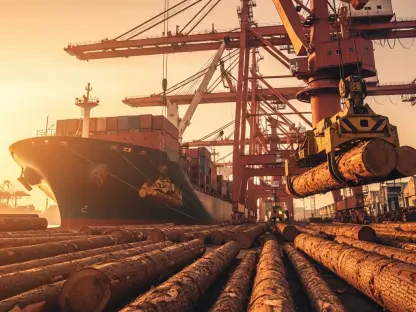The global polymers market is undergoing a significant shift as the developing world, excluding China, is being eyed to drive the next wave of demand. China’s exponential growth, which has heavily influenced the market for nearly three decades, is now showing signs of deceleration. This change prompts industry analysts to examine if and how countries like Turkey, Vietnam, Mexico, India, Brazil, and Indonesia could fill the emerging gap in polymers demand. The complexities of these markets and their potential to take a more central role in the global polymers industry form the crux of this discussion.
Shifting Dynamics in the Global Polymers Market
The polymers industry, traditionally driven by China’s rapid economic expansion, is now at a crossroads. With China’s growth cooling off, there is an urgency to identify new growth territories. This puts developing countries under the lens, offering a blend of opportunities and challenges influenced by various factors, including economic conditions, geopolitical tensions, and demographic changes.
Turkey presents a clear example of the shifting dynamics. Its strategic geographic and economic ties with the European Union, the Middle East, North Africa, and Central Asia position it as a potential hub for increased polymers demand. As these regions further develop their manufacturing sectors, the need for polymers—a key component in various industries—will likely see a corresponding rise. This underscores how geographic advantages can complement economic strategies to reshape the global polymers landscape.
But Turkey is not alone; other developing countries are forging their paths as well. Vietnam’s brisk industrialization and integration into global supply chains position it favorably in the polymers market. Similarly, India’s vast and growing population represents a substantial market. These economic and demographic dynamics are critical in presenting these nations as viable alternatives to China.
Turkey: A Strategic Manufacturing Hub
Turkey’s geographic location and strategic economic ties make it a standout candidate in the polymers demand narrative. Positioned as a bridge between Europe, the Middle East, and Asia, Turkey offers an advantageous hub for manufacturers aiming to reach diverse markets. Moreover, Turkey’s robust infrastructure supports a thriving manufacturing sector, driving polymers consumption as local production scales up.
Despite economic challenges, such as fluctuating interest rates and a volatile currency, businesses in Turkey maintain optimism. The youthful demographics provide a significant demand boost, with younger populations driving consumption and economic activity. This positive outlook is bolstered by Turkey’s pragmatic foreign policy, which maintains favorable relations with various geopolitical players like the West, Iran, Russia, and China. Such diplomatic agility means Turkey is poised to benefit from the reshoring strategies of Western countries and increased Chinese investments circumventing higher tariffs.
Economic indicators and demographic trends often reveal much about a country’s growth potential. Turkey’s youthful population hints at continued economic vigor, even as birth rates decline. This dynamic youthfulness, coupled with a strong higher education system, is expected to support Turkey’s ambitions to move up the manufacturing value chain, driving more sophisticated demand for polymers.
Economic and Demographic Factors Influencing Demand
Economic conditions and demographic trends are fundamental in shaping polymers demand in developing countries. A youthful population and a robust education system form the bedrock of economic growth and industrial advancement. In Turkey, demographic data shows promise, although the birth rate is declining and the population may reach the end of its growth spurt by 2047. Even then, Turkey’s current youthful population will drive demand for at least another two decades.
India provides another compelling case study. As one of the world’s most populous countries, India’s sheer numbers dictate a substantial market for polymers. Its ongoing efforts in industrialization and infrastructure development further elevate its status as a potential key player in the polymers industry. Vietnam follows a similar trajectory with its rapid industrial growth and integration into global supply chains, positioning itself as an ascending force in polymers demand.
Comparatively, Brazil and Indonesia also exhibit significant promise. Brazil’s vast natural resources and extensive domestic market offer fertile ground for polymers demand, although political and economic instability remain persistent concerns. Indonesia, with its large population and strong industrial sector, presents keys to potential growth once infrastructural and regulatory issues are addressed. Each country’s unique economic and demographic landscape will play a decisive role in their capability to absorb and enhance global polymers demand.
The Role of Geopolitical Tensions and Trade Shifts
Geopolitical tensions, most notably between China and the West, are redefining global trade flows in a way that creates both challenges and opportunities. Volatility in trade relationships has opened doors for other nations to position themselves as new hubs of manufacturing and trade. Countries like Turkey stand to gain from reshoring strategies employed by Western nations, aiming to reduce dependency on China.
Additionally, increased Chinese investments in third-party nations like Turkey aim to navigate around escalating tariffs and trade barriers. This strategic realignment benefits countries willing to adapt quickly to the changing dynamics of global trade. Similar opportunities exist for Mexico, given its proximity to the United States and integration into North American trade agreements. Mexico stands as a strategic partner in reshoring efforts, capitalizing on its location and economic policies to attract polymers-related investments.
Developing countries can also leverage geopolitical circumstances to strengthen economic alliances and build robust trade networks. Turkey’s balanced foreign policy interactions with diverse geopolitical players ensure it remains an attractive hub amidst the shifting trade dynamics. Maximizing benefits from these geopolitical shifts requires careful balancing of international relations with targeted economic strategies.
Comparative Analysis of Future Scenarios
Predicting the future trajectory of polymers demand involves navigating through a web of variables—economic growth rates, demographic trends, and geopolitical influences all intermesh to influence outcomes. ICIS forecasts suggest that China’s per capita polymers demand will surpass Turkey’s by 2025, but alternate scenarios indicate Turkey might close the gap should it maintain faster growth rates. If Turkey can attain an annual growth rate of 3% while China slows to 1%, Turkey could potentially overtake China in per capita polymers consumption.
However, China’s considerable population size ensures its absolute demand will remain higher, underscoring the complex nature of forecasting in the global polymers market. The contrasting growth dynamics between China and Turkey illustrate the broader uncertainties and possibilities. China’s slowed yet massive demand juxtaposed with Turkey’s rapid, albeit smaller-scale growth, paints a nuanced picture of the future global polymers landscape.
These projections highlight the necessity for flexible and nuanced approaches in developing strategies within the polymers industry. Companies and policymakers must account for rapid changes and adapt to shifting demand centers efficiently. Doing so requires an understanding of the intricate interplay between economic indicators, demographic trends, and geopolitical shifts.
Opportunities and Challenges for Developing Countries
Harnessing the potential of developing countries to replace China’s dominance in the polymers market involves navigating both opportunities and challenges. These nations boast unique advantages such as favorable demographics, strategic economic ties, and burgeoning industrial sectors. Yet, they also face significant hurdles, from economic volatility to political instability and infrastructural gaps.
Brazil exemplifies this duality. Its abundant natural resources and large domestic market create enormous potential for polymers demand. Nevertheless, political uncertainty and economic fluctuations could impede this potential. Similarly, Indonesia’s burgeoning industrial sector and large population offer promising opportunities, but realizing this potential depends on overcoming infrastructural and regulatory challenges.
Industries in these countries must focus on strengthening their resilience and adaptability to overcome such barriers. Investments in infrastructure, regulatory reforms, and political stability can pave the way for sustained growth in the polymers sector. By addressing these challenges, developing countries can position themselves as reliable stakeholders in the global polymers market.
Leveraging Human Capital and Education Systems
The global polymers market is experiencing a notable transition as attention shifts to developing countries, minus China, to spearhead the upcoming surge in demand. China’s remarkable growth, which has considerably shaped the market for nearly thirty years, is now plateauing. This slowdown leads industry experts to investigate whether nations such as Turkey, Vietnam, Mexico, India, Brazil, and Indonesia can step up to fill the prospective demand gap in the polymers sector.
The focus of this discussion centers around the intricacies of these emerging markets and their capacity to assume a more pivotal role in the global polymers industry. Each of these countries presents unique factors—ranging from economic conditions and industrial capabilities to regulatory environments—that could influence their ability to drive future demand.
Furthermore, with China’s market maturing, the attention on developing nations is not just a matter of filling a void, but also leveraging diverse growth opportunities. These countries have burgeoning industries and increasing consumer bases, which could collectively create a substantial impact on the global polymers market. The transition invites careful analysis to gauge whether these nations can indeed rise to meet the anticipated demand and maintain the industry’s growth momentum on an international scale.









